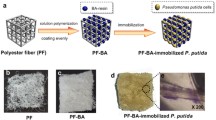Abstract
Biotreatment of wastewaters containing toxic compounds can be jeopardized by surges in substrate concentration. Preventative measures include tight monitoring and control to either dilute high concentration transients, or to divert them to surge tanks for later release and treatment. Using phenol as a typical toxic substrate, we have imposed 4 h phenol surges of 3,000, 6,000 and 8,000 mg/l from a steady-state feed of 500 mg/l, demonstrating such reduced treatment efficiency. In contrast, with the addition to the bioreactor of a small amount (3–10 % w/v) of inert polymer beads (Hytrel 8206) possessing a high affinity for phenol (partition coefficient of 39), significant detoxification was achieved, resulting in a 100 % increase in treatment efficiency, and good performance at phenol surges of up to 16,000 mg/l. The addition (passive operation) of polymers to a biotreatment system eliminated the need for intervention during toxic transients while, at the same time, demonstrating that the polymers perform this function automatically and at all times (aggressive operation).




Similar content being viewed by others
References
Ahamad PYA, Kunhi AAM (2011) Enhanced degradation of phenol by Pseudomonas sp. CP4 entrapped in agar and calcium alginate beats in batch and continuous processes. Biodegradation 22:253–265
Collins LD, Daugulis AJ (1996) Use of a two phase partitioning bioreactor for the biodegradation of phenol. Biotechnol Tech 10:643–648
Daugulis AJ, Tomei MC, Guieysse B (2011) Overcoming substrate inhibition during biological treatment of mono-aromatics: recent advances in bioprocess design. Appl Microbiol Biotechnol 90:1589–1608
Fam H, Daugulis AJ (2012) Substrate mass transport in two-phase partitioning bioreactors employing liquid and solid non-aqueous phases. Bioprocess Biosyst Eng. doi:10.1007/s00449-012-0725-1
Hamoda MF, Al-Haddad AA, Abd-El-Bary MF (1987) Treatment of phenolic wastes in an aerated submerged fixed-film (ASFF) bioreactor. J Biotechnol 5:279–292
Kwon KH, Yeom SH (2009) Optimal microbial adaptation routes for the rapid degradation of high concentration of phenol. Bioprocess Biosyst Eng 32:435–442
Li Y, Loh K (2007) Continuous phenol biodegradation at high concentrations in an immobilized cell hollow fiber membrane reactor. J Appl Polym Sci 105:1732–1739
Loh K, Chung T, Ang W (2000) Immobilized cell membrane bioreactor for high strength phenol wastewater. J Environ Eng 126:75–79
Pawlowsky U, Howell JA (1973) Mixed culture bio oxidation of phenol. I. Determination of kinetic parameters. Biotechnol Bioeng 15:889–896
Prpich GP, Daugulis AJ (2004) Polymer development for enhanced delivery of phenol in a solid–liquid two-phase partitioning bioreactor. Biotechnol Prog 20:1725–1732
Prpich GP, Daugulis AJ (2005) Enhanced biodegradation of phenol by a microbial consortium in a solid–liquid two phase partitioning bioreactor. Biodegradation 16:329–339
Prpich GP, Daugulis AJ (2006) Biodegradation of a phenolic mixture in a solid-liquid two phase partitioning bioreactor. Appl Microbiol Biotechnol 72:607–615
Prpich GP, Daugulis AJ (2007) A novel solid–liquid two-phase partitioning bioreactor for the enhanced bioproduction of 3-methylcatechol. Biotechnol Bioeng 98:1008–1016
Prpich GP, Rehmann L, Daugulis AJ (2008) On the use, and re-use, of polymers for the treatment of hydrocarbon contaminated water via a solid–liquid partitioning bioreactor. Biotechnol Prog 24:839–844
Safont B, Vitas AI, Penas FJ (2012) Isolation and characterization of phenol degrading bacteria immobilized onto cyclodextrin-hydrogel particles within a draft tube spouted bed bioreactor. Biochem Eng J 64:69–75
Sipma J, Osana MB, Emanuelsson MAE, Castro PML (2010) Biotreatment of industrial wastewaters under transient-state conditions: process stability with fluctuations of organic load, substrates, toxicants, and environmental parameters. Crit Rev Environ Sci Technol 40:147–197
Tomei MC, Rita S, Angelucci DM, Annesini MC, Daugulis AJ (2011) Treatment of substituted phenol mixtures in single phase and two-phase solid–liquid partitioning bioreactors. J Hazard Mater 191:190–195
Yang R, Humphrey A (1975) Dynamics and steady state studies of phenol degradation in pure and mixed cultures. Biotechnol Bioeng 17:1211–1235
Author information
Authors and Affiliations
Corresponding author
Rights and permissions
About this article
Cite this article
Hagesteijn, K.F.L., Daugulis, A.J. Passive/aggressive detoxification of continuous flow biotreatment systems using absorptive polymers: partitioning bioreactors treating transient phenol loadings. Biotechnol Lett 34, 1817–1824 (2012). https://doi.org/10.1007/s10529-012-0965-9
Received:
Accepted:
Published:
Issue Date:
DOI: https://doi.org/10.1007/s10529-012-0965-9




